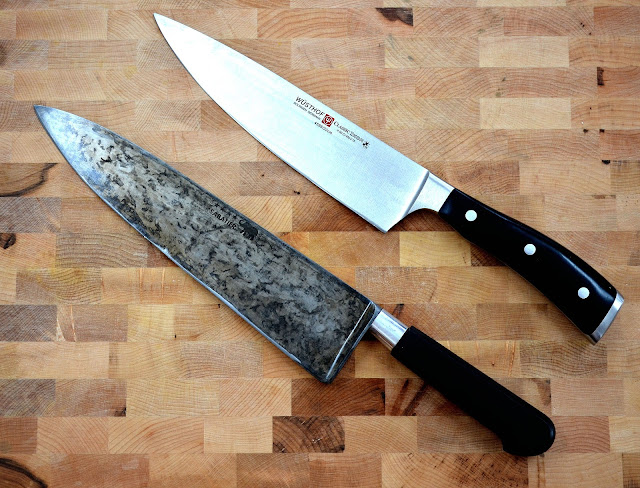 | |
| Pictured above: Real Knives |
 |
| From top: 10 inch chef's knife (carbon steel), 8 inch chef's knife (stainless), tomato knife, pairing (or petty) knife, cleaver |
 |
The chef's knife is the workhorse of the kitchen, big and heavy this critter is used for everything from chopping onions to cleaving squash and cutting lanyards off peppers. Many people own knife sets yet never use the Chef's knife fearing it's weight and heft which can seem a bit menacing. However, once you've learned how to grip the knife and use your other hand in a grip known as "the claw" you'll be safer than you'd think! If your knife is properly sharpened and has good heft to it, it will cut right through things instead of slipping off, which is one of the most common knife injuries. This is why a good, sharp chef's knife is actually crucial to safe cooking, doesn't hurt that it looks cool too! A chef's knife gains most of its importance from its size and weight, cleaving through all sorts of food but also being the best profiled for chopping. Knives with a German profile (right) tend to have a rounded belly on the blade which allows you to rock chop, sliding back and forth across the belly to have that effect that chef's love to show off. French profiled knives (left) have less of a belly and tend to have thinner blades, they sacrifice the ability to rock chop well for more control and an often sharper blade. If you're going to put money into a knife, this one is definitely the most important!The chef's knife is splurge worthy, and it isn't uncommon to drop a good 150$ or more for one. There are some decent lower end ones available in the 30-40$ range made by brands like calphalon, victorinox and forschner (the two last ones being owned by the same company) they're good for the cost but if you're serious about getting good knives I'd recommend spending a lot the first time and never spending again. A great higher end knife for less than 200$ is the antique sabatier pictured above on the left, it's a lovely knife so far and fulfills all expectations given to me by those who suggested it!
The Petty
The petty (pairing) knife is probably the knife that is found most often in people's kitchens. Coming in all shapes and sizes, available with serrated or straight edges, this little knife is cherished for its agility and easy control. It's great for removing stems from fruits and vegetables, seeding and if it's thin enough it can be slipped through joints on meat if you lack a boning knife. This is a great knife to have around for the little things but not great for the bigger stuff like chopping an onion, best to leave that to the chef's knife! Different shapes lend themselves to different uses of course and there are a whole bunch of different pairing knife profiles to try out. It's good to know where you prefer your point to be before buying a nice one. However, a cheap straight edged pairing knife (or 5) from the dollar store can be ok when starting out. For a bit more I'd recommend a few victorinox pairing knives with plastic handles available for 5-6$ each.
The Slicing Knife
The slicing knife, pictured above the petty, is what most meat eaters would consider the third most important knife to have around. As I don't often indulge in meat, I rarely reach for it, but this long, thin and rather graceful looking blade is great for producing nice uniform slices of meat. They're often thin and extremely sharp with many being available with completely straight blades. I picked up this particular one from a great brand from a thrift store (lucky me!).
Other information
It's important to know the different parts of a knife so you can understand all the debates around different shapes and such. Although I already mentioned a bit about blade profiles, for more information on what parts of the knife are where, I found this handy dandy diagram right here: www.cookingforengineers.com/article/130/Knife-Parts
As you can see from the diagram, many of the knives pictured here are "full-tang" meaning that they feature a tang reaching throughout the handles, sided by two scales and fixed with rivets. These knives are generally considered as more solid and reliable, a mark of a good knife. However, the old fashioned "rat-tail" pictured on the two knives above that do not have a full-tang is also pretty sturdy and I've yet to here bad reviews from anyone who owns one. However, they're not currently in favour and are truly a hallmark of a long ago age in knife-making. The large chef's knife in the first two photos is only a few decades away from being a century old and it's a fantastic piece.
This is only the first of a few posts on knives, more will be said at a later time about technique, sharpening, honing, brands and a whole bunch of other topics.
a few parting tips:
-Never store good knives in a drawer, use a block or magnet
- Never, ever put them through a dishwasher
-Use good knives on good cutting boards, optimally end-grain wood (that checkerboard pattern you saw), if not, at least make sure it's a wooden board
-Wash and dry your knife as soon as possible after use, this is doubly important with carbon steel knives
-Always keep your knives sharp, they're safer that way
For anyone looking to buy a knife, I highly recommend the forums over at cheftalk.com, they guided me through buying some of my knives and were a huge help. Hope this helps!


No comments:
Post a Comment